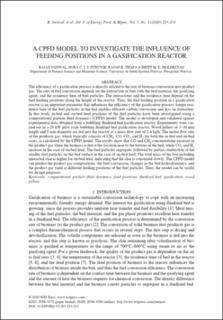| dc.contributor.author | Jaiswal, Rajan | |
| dc.contributor.author | Furuvik, Nora Cecilie Ivarsdatter | |
| dc.contributor.author | Thapa, Rajan Kumar | |
| dc.contributor.author | Moldestad, Britt Margrethe Emilie | |
| dc.date.accessioned | 2021-09-20T11:50:34Z | |
| dc.date.available | 2021-09-20T11:50:34Z | |
| dc.date.created | 2020-10-30T10:15:17Z | |
| dc.date.issued | 2020 | |
| dc.identifier.citation | Jaiswal, R., Furuvik, N. C., Thapa, R. K., & Moldestad, B. M. (2020). A CPFD model to investigate the influence of feeding positions in a gasification reactor. International Journal of Energy Production and Management, 5(3), 223-233. | en_US |
| dc.identifier.issn | 2056-3272 | |
| dc.identifier.uri | https://hdl.handle.net/11250/2779195 | |
| dc.description.abstract | The efficiency of a gasification process is directly related to the rate of biomass conversion into product gas. The rate of fuel conversion depends on the interaction of fuel with the bed material, the gasifying agent, and the residence time of fuel particles. The interactions and the residence time depend on the fuel feeding positions along the height of the reactor. Thus, the fuel feeding position in a gasification reactor is an important parameter that influences the efficiency of the gasification process; longer residence time of the fuel particles in the bed enables efficient carbon conversion and less tar formation. In this work, in-bed and on-bed feed positions of the fuel particles have been investigated using a computational particle fluid dynamics (CPFD) model. The model is developed and validated against experimental data obtained from a bubbling fluidized bed gasification reactor. Experiments were carried out in a 20 kW pilot scale bubbling fluidized bed gasification reactor. Wood pellets of 3–30 mm length and 5 mm diameter are fed into the reactor at a mass flow rate of 2.4 kg/h. The molar flow rate of the producer gas, which typically consists of CH4, CO, CO2, and H2 for both the in-bed and on-bed cases, is calculated by the CPFD model. The results show that CO and CH4 concentrations increase in the product gas when the biomass is fed at the location near to the bottom of the bed, while CO2 and H2 increase in the case of on-bed feed. The fuel particles segregate, followed by partial combustion of the smaller fuel particles on the bed surface in the case of on-bed feed. The total mass of the bed including unreacted char is higher for on-bed feed, indicating that the char is consumed slowly. The CPFD model can predict the product gas compositions, the fuel conversion, changes in the bed hydrodynamics, and the product gas yield at different feeding positions of the fuel particles. Thus, the model can be useful for design purposes. | en_US |
| dc.language.iso | eng | en_US |
| dc.title | A CPFD model to investigate the influence of feeding positions in a gasification reactor | en_US |
| dc.type | Journal article | en_US |
| dc.type | Peer reviewed | en_US |
| dc.description.version | publishedVersion | en_US |
| dc.rights.holder | © 2020 WIT Press. | en_US |
| dc.source.pagenumber | 223-233 | en_US |
| dc.source.volume | 5 | en_US |
| dc.source.journal | International Journal of Energy Production and Management | en_US |
| dc.source.issue | 3 | en_US |
| dc.identifier.doi | https://doi.org/10.2495/EQ-V5-N3-223-233 | |
| dc.identifier.cristin | 1843521 | |
| cristin.ispublished | true | |
| cristin.fulltext | original | |
| cristin.qualitycode | 1 | |
